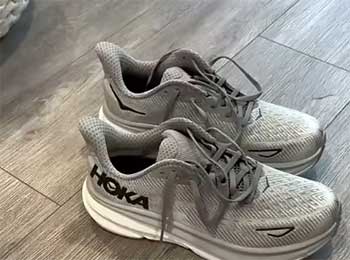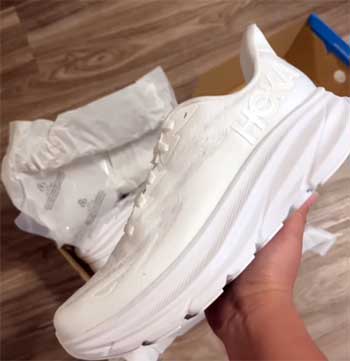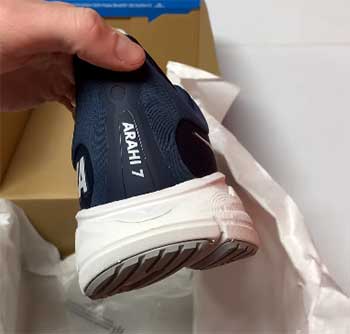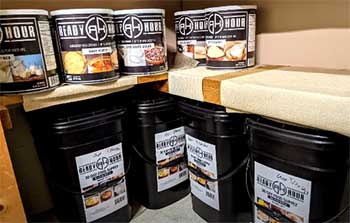I’ve been lacing up running shoes for years, pounding pavements and trails, chasing that perfect blend of comfort, support, and performance.
When it came to choosing between the Hoka Arahi 7 and Clifton 9, I knew I had to put them through their paces to see which one truly fits my stride—and maybe yours too. This article is my honest take on these two popular Hoka models, breaking down their features, pros, cons, and how they stack up for runners like us.
Let’s find out which shoe deserves a spot in your rotation.
A Brief Comparison Table
| Feature | Hoka Arahi 7 | Hoka Clifton 9 |
| Weight | Men: 9.9 oz, Women: 8.1 oz | Men: 9.8 oz, Women: 8.7 oz |
| Heel-to-Toe Drop | 5 mm | 5 mm (8 mm in Clifton 10) |
| Stack Height | Men: 34 mm heel, 29 mm forefoot | Men: 43 mm heel, 38 mm forefoot |
| Stability | Moderate (J-Frame technology) | Neutral (Sidewalls for mild support) |
| Cushioning | Balanced, firm CMEVA foam | Plush, softer CMEVA foam |
| Best For | Stability-focused runs, overpronation | Neutral runners, long runs, recovery |
| Fit | Snug, narrow toe box (wide available) | Snug, slightly roomier toe box (wide available) |
| Price | ~$145 | ~$145 |
| Durability | 500+ miles | 300-400 miles |
| Breathability | Good, engineered knit upper | Excellent, streamlined mesh upper |
My First Impressions: Stepping Into The Arahi 7 and Clifton 9
When I first slipped into the Hoka Arahi 7, I noticed its snug, structured fit right away. It felt like the shoe was hugging my foot, especially around the midfoot, thanks to its engineered knit upper and plush tongue.
The heel counter locked my foot in place, and the J-Frame technology gave me a sense of stability I hadn’t felt in other Hokas. It’s not a heavy shoe at 9.9 ounces for men, but it has a grounded, firm feel that screams control.
The Clifton 9, on the other hand, felt like stepping onto a cloud. At 9.8 ounces for men, it’s slightly lighter, and the softer CMEVA foam midsole gave my feet that pillowy sensation Hoka is famous for.
The upper, made of a breathable mesh, felt less restrictive than the Arahi’s, with a bit more room in the toe box. Right off the bat, I could tell these shoes were built for different runners, but I needed to hit the road to see how they performed.
Breaking Down The Key Features

Let’s talk about what makes each shoe tick.
The Arahi 7 is Hoka’s flagship stability shoe, designed for runners who overpronate—when your foot rolls inward too much during a stride.
Its standout feature is the J-Frame, a denser foam that wraps from the heel along the medial side to the forefoot, guiding your foot to prevent excessive rolling.
The midsole uses compression-molded EVA (CMEVA) foam, which feels firm yet responsive, with a 34 mm heel stack and 5 mm drop for a balanced ride.
The upper is a zonally engineered knit, offering breathability and a secure lockdown, though the toe box is on the narrower side.
The Clifton 9, Hoka’s poster child for neutral runners, prioritizes cushioning over everything else. Its CMEVA foam midsole is softer and thicker, with a 43 mm heel stack that absorbs impact like a dream.
The 5 mm drop (8 mm in the newer Clifton 10) keeps things consistent with the Arahi, but the lack of a J-Frame means it’s not built for stability. Instead, it uses sidewalls and a wider sole flare for mild support. The upper is a streamlined mesh, making it more breathable and slightly roomier than the Arahi’s.
Taking Them For A Spin: My Testing Experience
To get a real feel for these shoes, I wore them for a month, alternating between the Arahi 7 and Clifton 9 for runs, walks, and gym sessions. My routine included 5K tempo runs, long 10-mile jogs, and casual strolls around town. I have a neutral gait with a slight tendency to overpronate, so I was curious to see how each shoe handled my stride.
Hoka Arahi 7: Stability That Packs A Punch
My first run in the Arahi 7 was a 5K on a paved trail. The J-Frame technology immediately made its presence known, gently guiding my foot to stay aligned without feeling intrusive. It’s not like those old-school stability shoes with clunky medial posts; the Arahi’s support is subtle but effective.
The firm midsole gave me a snappy, responsive ride, which I appreciated during faster-paced runs. At 9.9 ounces, it felt light enough for tempo work, though it lacked the bounce I’d want for speed sessions.
For longer runs, the Arahi 7 held up well. I took it on an 8-mile loop, and the cushioning kept my feet comfortable without feeling mushy. The meta-rocker geometry—a curved sole that promotes a smooth heel-to-toe transition—made each stride feel effortless.
However, the narrow toe box started to pinch after mile 6, especially since my feet swell slightly on longer runs. If you’ve got wider feet, the wide version might be a better bet.
I also wore the Arahi 7 for casual walking and gym workouts. Its firm midsole and stable base made it great for cross-training, but I noticed the outsole struggled on wet surfaces. The rubber coverage is minimal, and I slipped slightly on damp pavement.
Durability, though, is a strong point—testers report the Arahi lasting over 500 miles, and I didn’t see significant wear after my month of use.
Hoka Clifton 9: A Cushioned Dream For Easy Miles

Switching to the Clifton 9, I felt like I was running on marshmallows.
My first 5-mile run on a city sidewalk was pure bliss—the plush CMEVA foam soaked up every impact, making my joints feel pampered.
The meta-rocker was just as smooth as the Arahi’s, but the softer midsole gave a more forgiving ride, perfect for recovery days or long, easy runs.
At 9.8 ounces, it’s barely lighter than the Arahi, but it felt airier thanks to the breathable mesh upper.
On a 10-mile run, the Clifton 9 shone for comfort but showed its limits. The lack of stability features meant my slight overpronation wasn’t corrected, and I felt a bit of foot fatigue toward the end.
It’s not a dealbreaker for neutral runners, but if you need support, this isn’t your shoe. The toe box was slightly roomier than the Arahi’s, which my feet appreciated on longer runs, though it’s still snug compared to brands like Altra.
In the gym, the Clifton 9 was less impressive. The soft midsole felt unstable during lateral movements like lunges, and I preferred the Arahi’s firmness for cross-training.
Durability is a concern here—multiple runners note the Clifton’s foam compressing after 300-400 miles, and I noticed slight wear on the outsole after my testing period. Breathability, however, was top-notch, keeping my feet cool even on warm days.
Pros And Cons of Hoka Arahi 7 And Clifton 9
Hoka Arahi 7 Pros
- Effective Stability: The J-Frame technology is a game-changer for overpronators, offering subtle guidance without feeling restrictive. It kept my stride aligned during long runs.
- Responsive Ride: The firm CMEVA midsole delivers a snappy, energetic feel, making it versatile for tempo runs and daily training.
- Durable Build: With over 500 miles of reported longevity, the Arahi 7 is a workhorse that can handle heavy mileage.
- Comfortable Upper: The engineered knit upper and plush tongue provide a secure, premium lockdown, ideal for long hours on your feet.
- Versatile Use: Great for running, walking, and gym workouts, especially for those needing stability.
Hoka Arahi 7 Cons
- Narrow Toe Box: The snug fit, especially in the forefoot, can be uncomfortable for wider feet or long runs unless you opt for the wide version.
- Limited Traction: The outsole’s minimal rubber coverage slips on wet surfaces, which is a bummer for rainy days.
- Firm Ride: If you prefer a plush, bouncy feel, the Arahi’s firm midsole might feel too rigid.
- No Reflectivity: The lack of reflective elements makes it less ideal for evening runs, a surprising oversight for a daily trainer.
Hoka Clifton 9 Pros
- Plush Cushioning: The soft CMEVA foam and high stack height make every step feel like a hug for your feet, perfect for long runs and recovery days.
- Breathable Upper: The streamlined mesh keeps your feet cool, even on hot summer runs.
- Smooth Transitions: The meta-rocker geometry ensures a fluid heel-to-toe roll, enhancing running efficiency.
- Lightweight Feel: At 9.8 ounces, it’s surprisingly light for a max-cushioned shoe, making it versatile for daily training.
- Wide Availability: Available in wide sizes, it accommodates more foot shapes than the Arahi.
Hoka Clifton 9 Cons
- Limited Stability: Neutral design means no support for overpronators, which can lead to fatigue on long runs if you need guidance.
- Durability Concerns: The soft foam compresses faster, with some runners reporting breakdown after 300-400 miles.
- Not for Speed: The plush midsole feels sluggish for fast-paced runs or speedwork, better suited for easy miles.
- Snug Fit: While roomier than the Arahi, the forefoot can still feel tight for very wide feet.
How Hoka Arahi 7 And Clifton 9 Stack Up?
- Cushioning and Comfort

The Clifton 9 wins hands-down for cushioning.
Its 43 mm heel stack and softer CMEVA foam create a plush, cloud-like ride that’s unmatched for long runs or recovery days.
I felt like my feet were being pampered, especially after tough workouts.
The Arahi 7, with its 34 mm heel stack and firmer foam, prioritizes support over softness.
It’s comfortable but feels more controlled, which some runners might prefer for daily training.
If you’re after max cushioning, the Clifton is your go-to; if you need a balance of cushion and stability, the Arahi takes the lead.
- Stability and Support
This is where the Arahi 7 shines. The J-Frame technology makes it a standout for runners with mild to moderate overpronation, guiding your foot without feeling heavy-handed. I noticed less ankle roll on uneven surfaces compared to the Clifton.
The Clifton 9, being a neutral shoe, relies on sidewalls and sole flare for mild support, which works for neutral runners but falls short for those needing pronation control. If overpronation is an issue, the Arahi is the clear winner.
- Fit and Sizing
Both shoes run true to size, but the fit differs. The Arahi 7’s narrow toe box and snug midfoot felt restrictive on longer runs, especially for my slightly wider feet. The wide version might solve this, but it’s something to consider.
The Clifton 9 offers a bit more room in the toe box, though it’s still snug compared to brands like Topo Athletic. Both have plush, padded tongues and secure heel counters, but the Clifton’s mesh upper feels less constricting. If you prioritize a roomier fit, the Clifton edges out.
- Durability and Traction
The Arahi 7 is the durability champ, with its firm midsole and strategic rubber outsole lasting over 500 miles for many runners. I saw minimal wear after a month of mixed use. The Clifton 9, however, shows signs of foam compression and outsole wear sooner, typically around 300-400 miles.
Traction is a weak point for both, but the Arahi’s limited rubber coverage makes it slipperier on wet surfaces. The Clifton’s full ground-contact outsole fares slightly better but isn’t grippy enough for trails.
- Versatility
Both shoes are marketed as daily trainers, but their strengths differ. The Arahi 7’s stability and firm ride make it versatile for running, walking, and gym workouts, especially for overpronators. I found it reliable for tempo runs and cross-training.
The Clifton 9 excels for long runs, recovery days, and casual walking, but its soft midsole feels unstable for lateral movements in the gym. If you want a do-it-all shoe, the Arahi is more adaptable; for pure comfort, the Clifton is hard to beat.
- Price and Value
At around $145, both shoes are priced similarly, which is standard for premium running shoes. The Arahi 7 offers better value for runners needing stability, given its durability and versatility. The Clifton 9, while fantastic for comfort, loses some value due to its shorter lifespan.
If you’re a neutral runner logging high miles, the Clifton’s plush ride might justify the cost, but the Arahi’s longevity makes it a smarter long-term investment.
Who Are These Shoes For?

The Arahi 7 is your match if you overpronate or need a stable, responsive shoe for daily training.
It’s ideal for runners who want control without sacrificing lightness, and it doubles as a great walking or gym shoe.
If you have flat feet or mild pronation issues, the J-Frame will keep you aligned without feeling overbearing.
The Clifton 9 is perfect for neutral runners who crave maximum cushioning.
It’s a dream for long runs, recovery days, or anyone who spends hours on their feet—think nurses or teachers.
If you’re looking for a shoe that feels like a pillow and don’t need stability, the Clifton is your pick.
My Personal Verdict
After a month of testing, I’m torn. The Arahi 7 won me over with its stability and versatility. As someone with a slight overpronation tendency, I felt confident on longer runs, and the firm ride kept me energized. But the narrow toe box was a drawback, and I wished for better traction on wet days.
The Clifton 9, meanwhile, was my go-to for easy runs and recovery days. Its plush cushioning made every step feel effortless, but I missed the support on longer runs, and the durability concerns gave me pause.
If I had to choose, I’d lean toward the Arahi 7 for its all-around performance and longevity, especially since I need a bit of stability. But if comfort is your top priority and you’re a neutral runner, the Clifton 9 will make you feel like you’re floating.
Your choice depends on your foot type, running goals, and whether you prioritize cushioning or control.
Frequently Asked Questions (FAQ)
Yes, the Clifton 9 is a great choice for marathons if you’re a neutral runner. Its plush cushioning and high stack height make it ideal for long-distance comfort, though it may feel sluggish for faster paces.
The Arahi 7 is best for runners needing mild to moderate stability, especially those who overpronate. It’s great for daily training, recovery runs, and cross-training.
Yes, the Arahi 7’s J-Frame technology provides excellent support for flat feet, helping control overpronation and maintain alignment.
The Clifton 9 excels for neutral runners doing long runs, recovery runs, or casual walking. Its plush cushioning is perfect for high-mileage comfort.
Conclusion: Your Perfect Hoka Awaits
You’re standing at the crossroads of two fantastic Hoka shoes, and I’ve walked you through my experience to help you decide. The Arahi 7 is your steadfast partner if you need stability and a responsive ride to tackle overpronation or versatile workouts.
The Clifton 9, with its cloud-like cushioning, is your go-to for long, comfortable runs or all-day wear. Think about your foot type, running style, and priorities—stability or softness—and you’ll find the shoe that feels like it was made for you.
Lace up, hit the road, and let your perfect Hoka carry you forward.

